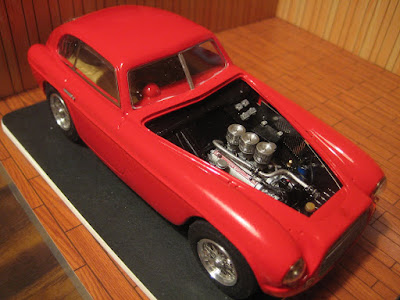So here's a review of what I achieved in 2019... only a baker's dozen +1, but all were good builds.
1. Porsche 908/03
This was a long standing occupant of the Shelf of Doom. I started it in late 2013 and finished it in January 2019. This is not an easy first Model Factory Hiro kit. The body doesn't quite fit due to all the little white metal bits not quite lining up, but still I am pleased with this devilishly complex little beast. A highlight of the year. I have a 1971 version of the same car in the stash and hope to do better the second time around.
2. Chevy Ambulance
This build for a friend, a retired paramedic, was a lot of fun.
3. Ferrari 166 MM Berlinetta
What a gorgeous little car! And this MFH kit, while hard to find these days, is not a difficult build compared to the 908/03. The equally gorgeous Barchetta is in the stash.
4. Cheetah
This is an excellent kit from Historic Racing Miniatures, sadly no longer available. What a brutal little monster it was, compared to the delicate 166 MM. Nobody ever really mastered the vicious handling on the track, and its history includes a string of DNFs. Still, it's a visually stunning car and historically interesting as a "what-if" story. So this makes four kits completed in January alone.
5. 1955 Corvette Speedster
This is a mild custom inspired by Briggs Cunningham's Le Mans cars, even though Briggs' cars were '58s. Various bits from the parts bin, such as the steel NASCAR wheels and Webers, round out the carefully trimmed windshield.
6. 1964 Rover 2000 TC in Monte Carlo trim
Having owned two Rover 2000 TCs (of which one actually ran!), I felt I needed a kit, and this 1/43 white metal kit from K&R is probably the only one out there. The vacuum formed windows were a beast... Here is the entire fleet of 1/43 builds.
7. Honda S800 rat rod
I had a lot of fun building up the body from sheet styrene. The rat rod ethos means it doesn't all have to fit all that well. And the hypothetical straight 8 of 1.6 litres is a neat idea. The chassis is the Honda S600 with two independently sprung chain drive cases to the rear hubs.
8. Ford Fairlane
This was meant as a tutorial on decent paint jobs with rattle cans. It came out pretty nice if I do say so myself, with only a few dust specks to mar the finish.
9. Lincoln Futura, aka proto-Batmobile
This was a quick build as there is very little detail in this oldie but goldie. I lowered it and swapped the wheels for something a little meatier, otherwise it was out of box (including the pastel blue paint job).
10. Subaru BRZ
This Tamiya kit was a gift, so I built it up out of box. It has enough engine detail to avoid the dreaded curbside tag, but detail is poor. A good starter kit.
11. Honda N360
I got my hands on a 1.6 litre VTEC motor from Hobby Design, and spent a lot of happy hours with the shoehorn. (The original motor, poorly detailed, is an air-cooled 360 cc twin from the motorcycle parts bin.) And this is where things stood in May...
12. BMW 320i
... until I completed this build in September. The kit, which has relatively poor underhood detail for a Tamiya kit, came with photo-etched details and a set of decals for the car driven by Gilles Villeneuve at Mosport; European cars were sponsored by Jagermeister but this was not allowed under Canadian alcohol advertising rules. Unilock makes paving bricks for driveways and patios.
13: Lotus Seven/Eleven
This Profil 24 resin body for slot car use fits the Tamiya Lotus 7 chassis relatively well, but the result is not historically accurate as the Eleven never had the double A-arm front end or the Cortina 1340 cc motor, and the Seven does not have the de Dion rear end with inboard discs. So I chose not to use the 1957 Le Mans decals provided by Profil 24; hopefully Jean-Philippe will see fit to make a version with the Coventry Climax motor...
14: 1964 Ford Falcon Sprint in Monte Carlo livery
A fun build of an interesting historical footnote. The Trumpeter kit of the Falcon Sprint is quite nice and the V8 is a close approximation of the Holman and Moody 289.

Additions include an oil cooler from Scale Production, and racing mirrors from the parts bin.

Wiring includes voltage regulator and battery, both firsts for me.


Stay tuned! There is more to come. Meanwhile best wishes for the holiday season and a happy, healthy, safe and prosperous 2020 to you all.






















































